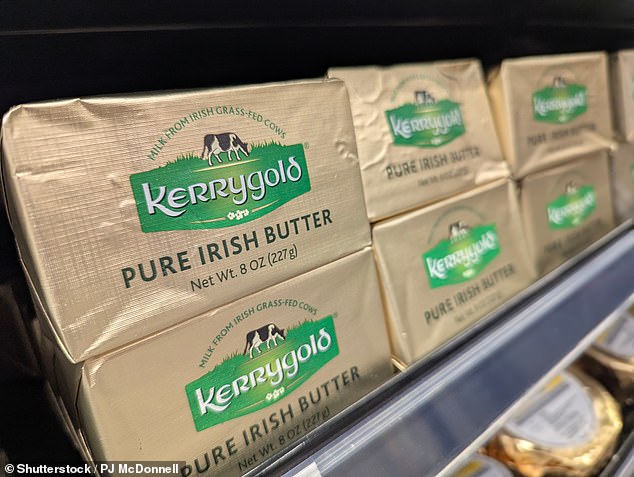Kerrygold has become the latest victim of shrinkflation after its parent company, Ornua, slashed the size of the beloved Irish butter blocks from 250g to 200g in the UK.
Despite the significant size change, retailers such as Asda and Waitrose have kept the original price, leaving customers worse off than before.
The butter, which retails at an average of £3 and is made with milk from Irish grass-fed cows, has long been a favourite for consumers, and even counts Kourtney Kardashian and Maura Higgins as fans.
However, since September, UK Kerrygold loyalists have had to cope with less butter per purchase after the brand introduced smaller packs.
The company made the change as a result of cost pressure in the industry, according to The Grocer.
Despite the decision to reduce the packaging size, Asda and Waitrose have kept the cost the same, resulting in a price per gram increase of over 25 per cent.
However, Tesco, Ocado, and Sainsbury’s have maintained the price per gram since the change, resulting in the relevant cost deduction, The Grocer found.
The Daily Mail has reached out to Ornua Foods UK.

Kerrygold has become the latest victim of shrinkflation as the butter blocks have reduced from 250g to 200g (stock image)
An Ornua Foods UK spokesperson told the outlet, ‘To ensure our products remain accessible to the growing number of shoppers who choose Kerrygold, we have adjusted the pack size, which brings Kerrygold block butter products in line with all of the other top five major block butter brands that have moved to 200g packs in recent years.
‘We are confident that Kerrygold, with its unique taste credentials and premium quality, continues to offer strong value and choice across the full range, which includes our 250g tub, 100g butter sticks and the 500g block introduced earlier this year.’
It comes after research found that some of the nation’s favourite Christmas chocolates have shrunk this year.
Despite the smaller sizes, prices have surged by as much as 33 per cent in some instances, and the rising cost of cocoa is partly to blame.
Quality Street tubs are among the sweet treats shrinking in size, going from 600g to 550g.
Although the box has decreased by 8.3 per cent, its pre-promotional price at Tesco, Sainsbury’s, and Morrisons has risen by 16.7 per cent year-on-year, The Grocer revealed.
The outlet noted that at budget supermarket Asda, the price of the 550g tub is cheaper than the 600g one was last year, dropping from £6 to £4.68.
Elsewhere, the 750g tin of Cadbury Roses has reduced from 750g to 700g in Morrisons, but the price has surged from £14 to £16.50.

The change results from cost pressures in the dairy industry, Kerrygold’s parent company said (stock image)
Terry’s Chocolate Orange has also faced similar changes, and has reduced by 7.6 per cent in size. However, in Tesco, the treat has faced a 33 per cent price hike.
In Sainsbury’s, the orange-flavoured chocolate has risen by 28.2 per cent in price, and by 25 per cent in Morrisons.
Toblerone is also facing changes, going from 360g to 340g, and costing more than before in Morrisons and Sainsburys.
A spokesperson for Toblerone and Cadbury told The Grocer that the changes were implemented as a ‘last resort’.
Discussing the Quality Street change, a Nestlé Spokesperson told the Daily Mail, ‘Each year we introduce a new Quality Street range with formats, sizes, weights and RRPs based on a range of factors including the cost of manufacturing, ingredients and transport and the preferences of our customers and consumers.
‘We think our 2025 range and pricing is competitive with a good variety of choice for Quality Street fans. Final prices are at the discretion of individual retailers.’
The Daily Mail has reached out to Mondelez International, and Terry’s Chocolate Orange for comment.
The change comes as rising temperatures and erratic rainfall have ‘hammered’ cocoa harvests in Ghana and Côte d’Ivoire, Cameroon and Nigeria, according to a report from Christian Aid.
These four West African countries are responsible for producing approximately 70 per cent of the world’s cocoa, the key ingredient in chocolate.
Cocoa prices have risen 400 per cent to $12,218 (£9,800) per ton after droughts, floods and climate-related diseases hit west African cocoa farmers last year, it said.
Higher temperatures and more irregular rainfall make growing conditions less than ideal for the cocoa tree, which relies on finely-tuned conditions to thrive.
Osai Ojigho, director of policy and public campaigns at Christian Aid, said climate change is ‘causing havoc’ to chocolate production.
‘Growing cocoa is a vital livelihood for many of the poorest people around the world and human caused climate change is putting that under serious threat,’ she said.
Humanity’s love for chocolate relies on the cocoa tree (Theobroma cacao), which thrives under specific conditions such as high humidity and abundant rain.
That’s why production of cocoa is limited to the tropics – the hot, humid region of the Earth that surrounds the equator.
Even then, a few countries dominate commercial production, including Ghana and Côte d’Ivoire, Cameroon and Nigeria in west Africa, Indonesia in Asia and Ecuador in South America.
Globally, Ghana and Côte d’Ivoire are the top producers, together accounting for about 58 per cent of the world’s cocoa, while African countries account for more than 70 per cent of the world’s cacao crop.
Christian Aid’s report warned that extreme weather last year caused failed harvests in west Africa, making temperatures too hot for cocoa growing.
In 2024, human-caused climate change added at least three weeks above 89.6°F (32°C) annually during the main cacao crop season (October-March) in Côte d’Ivoire and Ghana – above the optimal temperature range for the tree.
Over the same time period, climate change added just over two weeks above 32°C annually during the main crop season in Cameroon and more than one week in Nigeria.
The report said we are already in a cocoa shortage, which started in 2023, due to unexpectedly heavy rainfall during Ghana’s dry season followed by severe drought in 2024.
Total precipitation in west Africa in 2023 was more than double the 30-year average for the time of year and the wet conditions caused plants to rot.
Meanwhile, Ghana’s 2024 drought affected more than one million people, resulting in terrible crop losses and record-high food prices, the UN said
According to a prior study by World Weather Attribution, climate change made the heatwave in west Africa 10 times more likely.
The report also said changing climatic conditions may adversely affect the tiny midge pollinators, which cacao trees rely on to fertilize their flowers.
But our favourite chocolate bars, boxes and truffles are often also manufactured using other tropically-produced commodities, such as sugar, soy and sometimes palm oil, each of which ‘has its own climate-related supply chain vulnerabilities and wider environmental impacts’, the report said.
What’s more, the ongoing issue of deforestation means farmers do not have as much suitable land to grow cocoa.
Côte d’Ivoire and Ghana, for instance, lost 25 per cent and eight per cent respectively of their humid forests where the tree thrives between 2002 and 2019, said Cocoa Life.
Worryingly for the industry, the anticipated loss in cocoa yields is set to coincide with a increase in demand for chocolate, the report also warned